Category Archive 'Jewelry'
03 Apr 2024


It is the gold ring of Titus Carvilius Gemello.
The jewel was found on the finger of a Roman matron, the noblewoman Aebutia Quarta, in a Flavian-Trajanic tomb, now known as the ‘Hypogeum of the Garland’.
The tomb was discovered only in 2000 in the necropolis of Grottaferrata, near Rome.
According to Prometeo Magazine, the underground chapel contained two marble sarcophagi of excellent workmanship, decorated in relief and inscribed with the names of the two deceased: Carvilio Gemello and Aebutia Quarta.
When they opened the sarcophagi, the archaeologists were in for a huge surprise – the bodies were still intact.
The embalming they had been subjected to had allowed them to be in such an extraordinary state of preservation that Carvilio’s remains became known as the ‘Mummy of Rome’.
Carvilio’s body was wrapped in a shroud and completely covered with flowers.
Large, well-maintained garlands covered the upper half of the body, one of which was placed around the head. One of his femures was found fractured in two places.
In addition, a high percentage of arsenic was found in the hair, which means both septicemias caused by an injury or a fall from a horse and poisoning were hypothesized as the circumstances of his death.
Carvilio had died quite young, at the age of only 18. His mother, Aebutia, followed him a few years later, at the age of 40-45.
Aebutia’s body was barely perceptible, as it was covered with a plant mantle made up of hundreds of tiny garlands.
A well-preserved wig was placed on her head, wrapped in a net woven with fine gold double thread, and finished with a braid.
On the woman’s finger was a gold ring, with a bezel of rock crystal worked in cabochon, through the convex upper surface of which was seen the bust of a male figure finely executed on a sheet of micro-relief.
This creates a holographic image that fascinates the viewer, especially given the age of the jewel. The luminous effect of the crystal lens lends a mysterious depth to the image of the deceased.
Following the loss of her beloved son, Aebutia commissioned the precious gold ring to keep his memory alive.
The ring is currently on display at the Museo Archeologica Nazionale di Palestrina.
27 Jul 2020


A tourmaline and diamond flower brooch, by JAR. Designed as two green and pink tourmaline poppy flowerhead and bud, linked by a green tourmaline scrolling stem centering upon a pear-shaped diamond. Sold for CHF 1,179,000 on 14 May 2012 at Christie’s in Geneva.
Christie’s monthly magazine has a feature on a jeweler you and I can start patronizing for gifts for the little woman just as soon as we sell off our 50,000-acre cattle ranches.
Nice stuff, though.
Joel Arthur Rosenthal produces only around 70 imaginative, meticulously crafted pieces a year, making them highly sought-after by movie stars, tastemakers and collectors the world over
There’s no shop sign or window display at 7 Place Vendôme — nothing that hints at the brilliance within beyond three discreet letters, JAR. Yet for jewellery collectors, this is a place of pilgrimage: the store of the acclaimed contemporary jewellery designer, Joel Arthur Rosenthal.
Born in New York City in 1943, Rosenthal graduated in art history and philosophy at Harvard before moving to Paris. There, he opened a needlepoint shop, where his experiments with unusual colours of yarn attracted the custom of designers for Hermès and Valentino. After working with Bulgari in New York, he returned to Paris, opening his own jewellery store with his partner, Pierre Jeannet, in 1977.
Diamond and coloured diamond Trellis rarrings, JAR. Estimate $150,000-200,000. Offered in Magnificent Jewels on 29 July 2020 at Christie’s in New York
Diamond and coloured diamond ‘Trellis’ rarrings, JAR. Estimate: $150,000-200,000. Offered in Magnificent Jewels on 29 July 2020 at Christie’s in New York
JAR, as he is generally known, is celebrated for his creativity and his craftsmanship. He pairs unusual gemstones with non-traditional materials and has a daring way with colour and proportion. The quality of his work recalls the jewellery of the 18th and 19th centuries. In 2013, he was the first living ‘artist of gems’ to be honoured with a retrospective at the New York Metropolitan Museum of Art.
JAR only produces some 70 pieces a year. His ability to create jewels of unusual dynamism and architectural depth has made him a favourite with style icons, tastemakers and collectors the world over.
RTWT
28 Apr 2020
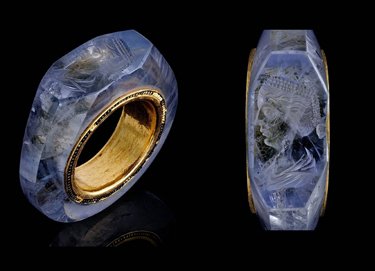
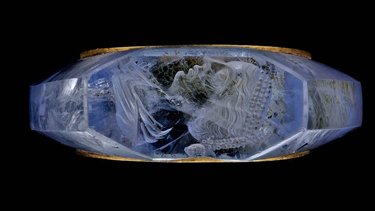
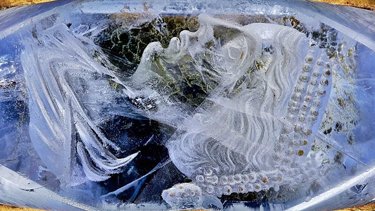
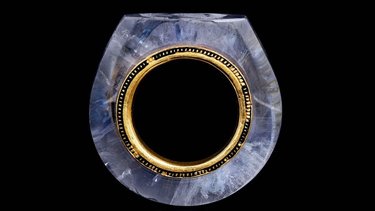
click on image for larger version.
Roman ring, with portrait of Cæsonia Milonia (died 24 January 41), the fourth and last wife of Roman emperor Caligula and a former priestess of the Egyptian goddess Isis. Caesonia had a bad reputation, as she was promiscuous, extravagant, deep in debt, and a divorcee, but Caligula decided to marry her so that she could produce him an heir. She was murdered along with Caligula and their three daughters in 41.
Cut sapphire (and intaglio representing the profile of the empress) and hollowed out and set in gold, early 1st century.
(Former collection of the Dukes of Marlborough, this exceptional ring was sold in October 2019 in London by London jeweler Wartski to an unknown buyer (estimated transaction £ 500,000 / € 570,000 — $ 622,145 / $ 709,245.30).
16 Jan 2018

“The cruel seas, remember, took him in November.”
England, 1592
19 Sep 2017

A brooch depicting the Grimaldi arms, which being the arms of a Prince are displayed beneath a mitre crown on a mantle of ermine, Fusily (or lozengy) argent and gules. The supporters (two monks wielding swords) refer to the conquest of Monaco in 1297, when François Grimaldi entered the city with soldiers dressed as monks, with swords hidden under their cassocks. The collar surrounding the shield is the Order of St. Charles, a Monaguesque order founded in 1858. The Grimaldi motto is Deo Juvante “With God’s help”.
19 Feb 2017


Vintage News:
One of the most mysterious and celebrated treasures from Anglo-Saxon England, the Alfred Jewel is believed to be more than 1,000 years old. It was discovered in 1693 in a field at North Petherton, Somerset.
Made of enamel and quartz, this remarkable jewel was made in the reign of Alfred the Great with an inscription “AELFRED MEC HEHT GEWYRCAN†which means “Alfred ordered me made.†It is an unusual example of Anglo-Saxon jewelry because it begs all kinds of questions about where the materials came from.
The two-and-a-half-inch long jewel made of filigreed gold has an image of a man, which many historians believe is a picture of Christ. Shaped like a teardrop, it was once believed that this jewel was a pendant worn around the neck. However, this would mean that the image of Christ would be permanently hung upside-down.
Another theory is that it might have been the centerpiece of a royal crown but the setting seemed inappropriate for that purpose. According to Webster, the back of the jewel is a flat gold plate which is engraved with either a plant motif or an image of the Tree of Life.
Over the years, many suggestions have been made about the function of this jewel. The most common is that it was a pointer to use for reading manuscripts. It is assumed that it may have been Alfred’s gift to the abbey, which he founded at Athelney in 878 after his defeat of the Vikings.
A description of the jewel was first published in the Philosophical Transactions of the Royal Society in 1698. Colonel Nathaniel Palmer bequeathed the jewel to Oxford University and it was on display in the Ashmolean Museum in Oxford. In 2015, after 297 years away, the Alfred jewel was put on display for one month at the Museum of Somerset, Taunton Castle.
15 Feb 2017


Vintage News had a feature article on a major historic find.
The Middleham Jewel is a late 15th-cenutry diamond-shaped gold pendant made by the finest medieval goldsmiths in London. It was found in 1985 near the Middleham Castle in North Yorkshire which was the childhood home of Richard III.
It is a remarkable piece of jewelry because of the engraving of the two scenes of the Trinity and Nativity.
There is a blue sapphire stone set on the front face which is connected with the Virgin Mary and it was believed that the jewel was made to assist childbirth. Another belief is that the jewel was providing protection against illness curing headaches and poor eyesight. Also, the sapphire may represent heaven or have acted as aid to prayer.
The circle of the sun surrounding the sapphire is in the shape of the letter “o†and it’s connected with the Greek word â€omega†which symbolizes the end, the completion. There are holes on the side of the jewel which indicate that there was a frame around it, possibly once decorated with pearls.
On the front side, there is a scene of the Trinity, including the Crucifixion of Jesus and there is a Latin inscription which was a common recitation by the priest in mass. There is one particular word ‘ananizapta’ for which it was believed that it is a magic word, intended to protect people from drunkenness or epilepsy.
On the back side of the jewel, there is an engraving of the Nativity, with fifteen saints around the Lamb of God. Only a few of the saints can be identified as St George, Catherine of Alexandria, St Peter, St Barbara, St Anne, Dorothea of Caesarea and St Margaret of Antioch.
There is evidence from the late 15-th century that this kind of jewel was worn by noble ladies. It may have been owned by Richard III’s wife, Anne Neville, his mother or his mother-in-law because they all spent time at Middleham.
When it was first found, the jewel was declared lost and was sold at Sotheby’s in 1986. In 1992, with support from many fundraisers, it was acquired by the Yorkshire Museum. There is a replica of the Middleham Jewel at Middleham and the original can be seen in the Yorkshire Museum.
29 Aug 2015

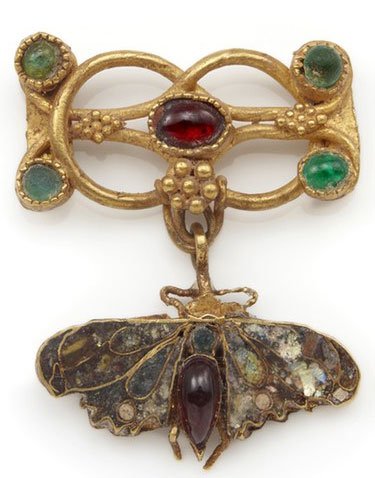
Brooch with Heracles knot and butterfly pendant, 300-100 B.C. Gold, Almandine, Emerald, Glass. Greece. Museum für Angewandte Kunst, Cologne. (Photo: Martin Kilmas.)
The marriage-knot or knot of Hercules, a strong knot created by two intertwined ropes, originated as a healing charm in ancient Egypt, but is best known for its use in ancient Greece and Rome as a protective amulet, most notably as a wedding symbol, incorporated into the protective girdles worn by brides, which were ceremonially untied by the new groom. This custom is the likely origin of the phrase “tying the knot.â€
According to Roman lore, the knot symbolized the legendary fertility of the God Herakles; it probably relates to the legendary Girdle of Artemis captured from the Amazon Queen Hippolyta. In this, the marriage-knot was probably a representation of the virginity of the bride.
The butterfly symbolizes the Greek princess Psyche, whose beauty was such as to provoke the envy and wrath of Aphrodite. The goddess’s revenge was foiled, however, when her son Eros fell in love with Psyche, and after various difficulties, persuaded the gods to make her immortal and thus his equal. Eros then married Psyche and the couple were bonded together eternally in passionate union.
This remarkable object was clearly made as a wedding present for a bride.
03 Jun 2015

A ROMAN GOLD AND GARNET WINGED THUNDERBOLT PENDANT
CIRCA 1ST CENTURY A.D.
From Christie’s.
14 Sep 2012

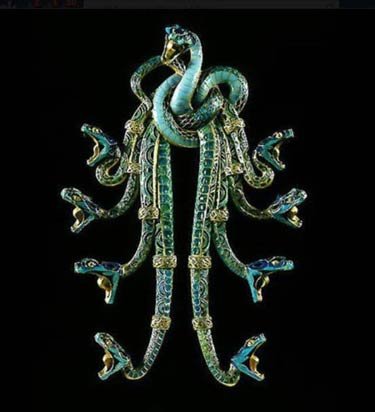
René Lalique, Serpents brooch, 1898-1899.
One of my European Facebook friends forwarded a photo of the above piece of jewelry, which I, at least, failed to recognize as Lalique.
My curiosity is strong, so I captured the picture and ran it through a search program (Tineye), thereby identifying its source as Odisea2008.com, a Spanish-language web-site regularly purveying images of art.
(I never actually studied Spanish, but for the convenience of my Anglophone readers, I have combined my own feeble efforts with Google translator to produce a readable (reasonably accurate, I hope) version of Odisea2008’s accompanying text.)
RENÉ LALIQUE, AN ARTISTIC GENIUS
René Lalique was born in 1860 and died in 1945, and lived two successive artistic lives, as he expressed different facets of his personality in two diametrically opposed styles: the Art Nouveau and the later Art Deco.
Basing his inspiration on nature and having had the audacity (for the time) to use the female body as an element of ornamentation, Lalique created some of the most representative jewelry of the Art Nouveau style. His earrings, brooches, tiaras, glasses, combs were original and imaginative works using the most elaborate techniques. He was not afraid to use previously little-used materials, such as horn, ivory, semi-precious stones, enamel and inlaid glass that was combined with gold and precious stones. His originality and talent caused him to be regarded by Emile Gallé as the inventor of modern jewelry.
At the height of his career as a jeweler, Lalique gradually changed direction and became a glazier. His earliest experiments dated back to the 1890s, but his encounter with the perfumer François Coty in 1908 played a decisive role, causing him not only to create produce bottles for the greatest perfumers, but gradually also to add to his productions, boxes, vases, lamps, and so on.
His reputation in the realm of glass was such that his factory at Combs-la-Ville, could not meet the demand, so after the World War, Lalique opened a second manufactury in Alsace at Wingen-sur-Moder, knowing that he could find in this region with a tradition of stained glass production the necessary skilled labor and that he would be able to obtain support from the government which at that time was seeking to establish the region of Alsace and Moselle as “the glass-center of France.”
Glazier of genius and eclectic creator, Lalique was not only interested in the arts of tableware and perfume bottles. He also produced, in the luxury years of the 1920s, equally emblematic designs for car radiator mascots, lighting for trains like the Orient-Express, for passenger ships like the Normandie, and for luxury stores. Lalique also took a special interest in religious architecture for which he produced some extraordinary designs.
After the death of Rene Lalique in 1945, his son Marc succeeded him in directing the company. Imbued with the same passion for the work, he used his technical skills to rebuild and modernize the factory largely destroyed during the war. Abandoning glass in favor of crystal, He exploited the contrast between the transparent and the satin-glazed to achieve the maximum expressivity from this pure material. It was this particular effect which became famous worldwide and was recognized as characterizing the brand “Lalique”. Under his guidance, the company quickly reached the highest position among the great French and foreign glassmakers.
Marie-Claude succeeded her father Marc in 1977, with the intention of combining tradition and renewal, along with the love of natural forms and the capability of reproducing and communicating their essence in objects, that for three generations has marked the creative sensibility of Lalique.
In 2008, the Lalique Company was merged into the Pochet Group of Art and Fragrance Companies and Saint-Germain Finance. The aim of its president and CEO, Silvio Denz is to strengthen the brand name in the world market and to increase its production capacity of glassware. Collections of jewelry and perfume bottles continue to be developed in parallel with traditional stained glass activity. Reissues of old works and contemporary creations are still produced in Wingen-sur-Moder by master glassmakers, where several of the best workers in France perpetuate the cult of excellence.
/div>

Feeds
|
















